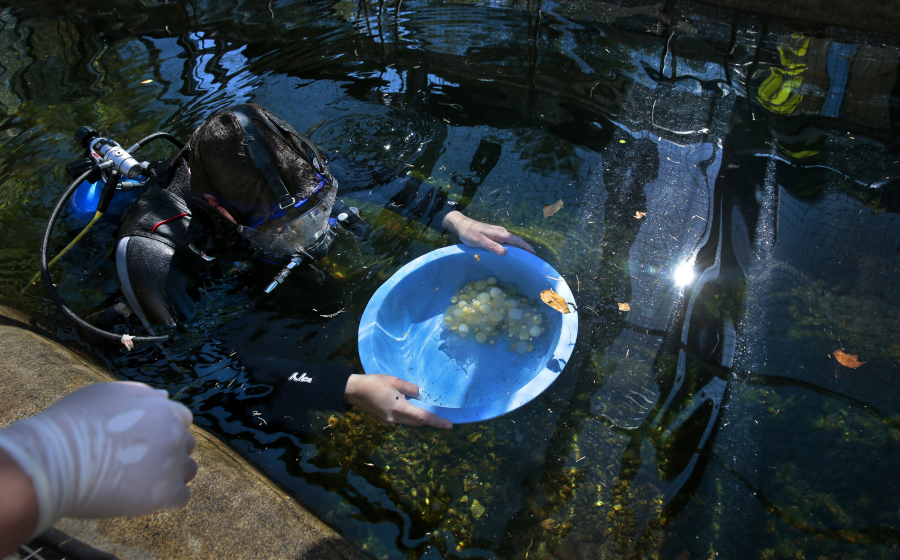ST. LOUIS — For spending their 160 million years of existence mostly hiding in rivers and streams under rocks, Eastern and Ozark hellbenders had done pretty well for themselves.
But in a matter of just a few decades, they’re quickly disappearing. They’re tricky to find simply because they like to hide under rocks, but more often than not, they’re not hiding there anyway because there are fewer around.
“Not only are we catching significantly fewer animals, we’re not catching little ones like we had in the past,” says Jeff Briggler, the Missouri state herpetologist.
Hellbenders are aquatic amphibians that are the largest salamander in North America by weight, reaching up to 5 pounds. They average about 20 inches long.
For more than 20 years, the St. Louis Zoo, the Missouri Department of Conservation and other agencies have worked together to turn back the clock and save the hellbenders, and believe their work has given the salamanders at least another 30 years. Their numbers have declined by 70 percent since 1990.
In August, the zoo and MDC celebrated the milestone of releasing the 10,000th hellbender raised in captivity back into native waters, and have since released hundreds more. They bred their first Ozark hellbenders in captivity in 2011 after a decade of trying.
The zoo has the only facility in the world that keeps and breeds Ozark hellbenders, with a few universities working at a smaller level with Eastern hellbenders. Both species, who have slight differences in size and color, are federally protected in Missouri. Missouri is the only state that has both kinds.
“From a natural history standpoint, they are one of the most specialized vertebrates on the planet. They are very exotic and bizarre and weird,” says Justin Elden, the zoo’s curator of herpetology.
They’ve been around so long they’re the subject of Ozark and Appalachian folk tales, and have acquired nicknames like the Allegheny Alligator, snot otter, mud devil and grampus.
The nickname “old lasagna sides” comes from the ruffles on its torso, which allow for more surface area to absorb oxygen. They have a rudder-like tail, blotchy, dark skin, a wide, flat head, and a face, Briggler says, only a mother could love.
“Once you get to know this animal, they’re gentle giants,” says Briggler. “Just because of the way they look — they’re ancient animals. You feel like you want to help them.”
A mix of factors have hurt the hellbender in the wild, including river pollution, changes to their environment such as the movement of rocks they like to hide under, disease and shifts in the river channels that make for faster or slower-moving water.
“They are a living fossil. They are basically the same animal now as they were millions of years ago,” says Elden. “But because they are a specialist for that very specific type of environment, if one thing changes, the whole haystack falls over.”
Herpetarium
Elden is also the director of the St. Louis Zoo WildCare Institute Ron and Karen Goellner Center for Hellbender Conservation. It’s a series of four rooms in the basement of the zoo’s herpetarium, as well as two rectangular-shaped pools behind the building. The pools simulate wild streams and serve as breeding areas.
About 2,000 hellbenders in various stages of development, from egg to adult, are being raised at the center now. Fall is hellbender breeding season, with males staying back at the nest guarding clutches of eggs they’ve fertilized until they’re ready to hatch.
But in the wild, the eggs and young hellbenders are particularly vulnerable. Keepers monitor nesting boxes at the bottom of the outdoor pools, and gather clutches of fertilized eggs so they can monitor and raise them in the controlled indoor environment.
The concrete nesting boxes, sometimes built by Briggler’s staff as a team-building exercise, are about the size and shape of a car muffler.
The fall is a good time to gather the eggs. In late September, hellbender keeper Katie Noble donned scuba gear, lowered herself into an outdoor pool, and ducked beneath the water.
She reached into a nesting box and slowly, carefully retrieved the clutch of fertilized eggs, a gelatinous clearish-whitish mass with a tiny yellow Ozark hellbender embryo inside each one. She stood and gently nudged the mass into a large, white plastic bowl.
“She’s got the whole world in her hands,” singsonged another keeper while gingerly carrying the bowl inside.
The keepers measured and weighed the adult male hellbenders that guarded the nests. The keepers named the pair Creed and Teddy. They’re characters from the shows “The Office” and “Bob’s Burgers,” which are the names of the outdoor pools.
The zoo has a staff of four full-time hellbender keepers, who monitor and take care of the young hellbenders and eggs as well as the water they live in. Once keepers bring the eggs inside, they check them and circulate the water constantly to keep the eggs healthy.
“In the wild, a male would be moving his tail over the nest during incubation and develop, so we mimic that here,” says keeper Patty Ihrig-Bueckendorf as she checks a tray of eggs in an incubator. One egg hatched prematurely, so she put the embryo inside a small mesh bag to protect it. It should grow fine that way, she says.
As they hatch and grow, the hellbenders get moved to larger tanks. There’s river gravel at the bottom of the tanks, as well as pieces of white PVC pipes and white wall tiles — the hellbenders like to hide inside the pipes and under the stacked tiles. Keepers dim the lights and try to leave the hellbenders alone until they’re old enough to release in the wild.



